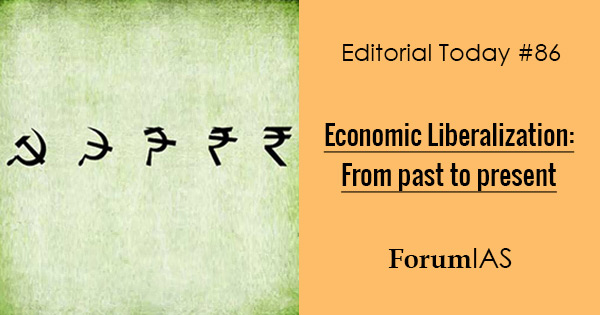 Immediate factors led to economic liberalization:-
Immediate factors led to economic liberalization:-
- Balance of payments situation became almost unmanageable.
- Fiscal deficits rose sharply from 4.1 per cent of GDP in 1974–75 to 6.5 per cent in 1979–80, 9.7 per cent in 1984–85, peaking at 10.4 per cent in 1991.
- Domestic debt rose from 31.8 per cent of GDP in 1974– 75 to 45.7 per cent in 1984–85 to 54.6 per cent in 1989–90.
- The foreign debt situation also became very precarious with debt rising from $23.5 billion in 1980–81 to $37.3 billion in 1985–86 to $83.8 billion 1990–91.
- Excessive dependence on foreign debt rather than foreign equity capital, and inadequate returns on the borrowings led to an unsustainable debt service burden.
- India’s foreign exchange reserves fell from $5.85 billion in 1980–81 to $4.1 billion in 1989–90, and in the next year (1990– 91) they fell drastically by nearly half to $2.24 billion enough only for one month’s import cover.
- The Iraqi invasion of Kuwait in August 1990, led to an increase in oil prices and a fall in Indian exports to the Middle East.
- Foreign lending had virtually dried up, the government was forced to sell 20 tonnes of gold to the Union Bank of Switzerland in March 1991.
What involved in the liberalization?
Several immediate reforms were made by liberalization, some important of which were:-
- Making the exchange rate more realistically linked to the market (the rupee underwent about 20 per cent devaluation at the very outset).
- Liberalization of trade and industrial controls.
- Considerable dismantling of the industrial licensing system and the abolition of the MRTP Act.
- Reform of the public sector including gradual privatization;
- Reform of the capital markets and the financial sector;
- Removing a large number of the restrictions on Multinational corporations and foreign investments
Achievements since liberalization
Following graph show a definite improvement in the last 25 years compared with the post-Independence period:-
- Decadal growth rates of India
Years Growth Rate
1950-51 to 1964-65 4.8 percent
1964-65 to 1974-75 3.4 per cent
1974-75 to 1984-85 4.2 per cent
1984-85 to 1994-95 5.9 per cent
1994-95 to 2004-05 7.1 per cent
2004-05 to 2013-14 8.3 per cent - Policy changes that began in the 1980s and were pursued more intensively after 1991 helped India escape the low “Hindu rate of growth” in which India had been trapped until then.
- Another achievement from a country which had seen its reserves fall to the equivalent of the value of its imports over two weeks in 1991, now holds large foreign exchange reserve, currently placed at $360 billion, equivalent to imports over more than 11 months.
- Our GDP is seven times larger (calculated at current prices).
- Foreign investment inflows that averaged $8-15 billion before 2004-05 rose to more than $60 billion in 2007-08 and, despite the crisis of 2008-09, recovered to more than $70 billion in 2014-15.
- The ratio of bank credit outstanding to GDP, which had remained at around 22 per cent for a decade starting 1989-90, began to rise after 1999-2000, doubled by 2005-06 and is currently well above 50 per cent.
- Share of infrastructural lending in the total advances of scheduled commercial banks to the industrial sector rose sharply, from less than 2 per cent at the end of March 1998 to 16.4 per cent at the end of March 2004 and as much as 35 per cent at the end of March 2015.
- We have achieved universal primary education with a 100% primary enrolment ratio.
What were the expectations by Liberalization?
- One of the motives was unleashing the competition to make domestic industries competitive to foreign industries.
- These domestic technologically upgraded industries were expected to stimulate exports and earn foreign exchange to pay for imports.
- It was expected to result in a restructuring of domestic industry, which would be forced by the cutting edge of competition to establish internationally competitive capacities.
- Liberalisation was also expected to attract foreign direct investors who, whether in collaboration with domestic partners or through investment in subsidiaries.
- Industry will be the leading sector in the growth process. Liberalization would help fulfil the promise India showed as a potential industrial power.
Criticism
- GDP based claims of growth ignores welfare.
- Appallingly poor state of physical and social infrastructure in the country could not be improved yet.
- In the 25 years since 1991, India has recorded a current account deficit on its balance of payments in all but three years.
- CAD implies that India has accumulated large currency reserves due to pumping of investments by foreign investors and lenders but trade. Hence these flows are inflows are liabilities and have associated with them payment commitments in future.
- It was not exports that supported the buoyancy experienced under the new regime, as was claimed would be the case by the advocates of liberalisation. Growth mainly was supported by service and construction sector.
- Manufacturing has not been the driver of growth in the country. In 2010, industry’s contribution to GDP stood at 47 per cent in China, 47 per cent in Indonesia, 39 per cent in South Korea, 44 per cent in Malaysia, and 45 per cent in Thailand. In India that contribution was only 27 per cent.
- India has also failed to raise its market share even in the case of traditional exports.
- 100% primary enrolment ratio has come with a very high drop-out rate of 20%.
- Only 6% of Indians above 15 years of age achieve higher education (as per Euro monitor data), while China is at nearly 12% for the same age group.
- 44% of people still defecate in the open.
- 10 of the top 20 most polluted cities in the world are in India

Leave a Reply